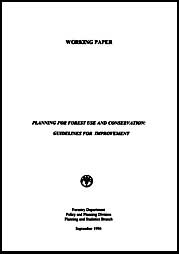
WORKING PAPER
FAO
Forestry Department
Policy and Planning Division
Planning and Statistics Branch
September 1996
This electronic document has been scanned using optical character recognition (OCR) software and careful manual recorrection. Even if the quality of digitalisation is high, the FAO declines all responsibility for any discrepancies that may exist between the present document and its original printed version.
A. Forest Use and Conservation and Sustainable Development: Changing perspectives and New Demands
B. Revisiting the Concept of Planning in Relation to Forests
CHAPTER 1: ISSUES THAT DEFINE THE PLANNING AGENDA
1.1 Inter-Sectoral and Macroeconomic Aspects
1.2 Enterprise Aspects
1.3 Environmental Aspects
1.4 Social and Community Aspects
1.5 Sustainability AspectsCHAPTER 2: PLANNING METHODS AND TOOLS
2.1 Methods to Clarify Issues and Problems
2.2 Methods to Examine Spatial and Inter-Sectoral Relationships
2.3 Methods for Social, Environmental, and Economic Analysis
2.4 Methods to Discuss the FutureCHAPTER 3: PLANNING AS A PROCESS OF CONTINUOUS IMPROVEMENT
3.1 Learning from Experience
3.2 Planning as Continuous Improvement: How It Should Work
3.3 At the End of a Process That Never Ends: What Are the Results of Planning?
3.4 Mission: You Cannot Plan Without One
3.5 Improvement Goals: Filling Performance Gaps
3.6 Objectives: Setting Targets
3.7 Strategies: Action Ideas
3.8 Negotiation: Seeking Agreement and Compromise
3.9 Implementation: The Management Dimension
3.10 Evaluation and Adjustment: Learning from ExperienceCHAPTER 4: TEN KEYS TO UNLOCK THE BENEFITS OF PLANNING
4.1 Key 1: Choose Your Planning Teams Wisely
4.2 Key 2: Avoid "Wish Lists"
4.3 Key 3: Dig Down to the Roots of Problems
4.4 Key 4: Put Out Fires While They are Small
4.5 Key 5: Keep It Short and Simple
4.6 Key 6: Coordinate Top-Down and Bottom-Up Efforts
4.7 Key 7: Emphasize Review and Adjustment
4.8 Key 8: Stop Controlling, Start Empowering
4.9 Key 9: Prepare to Negotiate
4.10 Key 10: Prepare to Deal With a Difficult Administrative Culture
CHAPTER 5: PUTTING PEOPLE AT THE CENTER OF PLANNING
5.1 When Participation Works, What Does It Accomplish?
5.2 Design a Framework for Participation: Overview
5.3 Develop the Participation Plan
5.4 Work With Regions and Districts
5.5 Work With Other Agencies
5.6 Work With Interest Groups
5.7 Work With Advisory Committees
5.8 Prepare a Participation Summary
5.9 Hold the Door Open for Continued ParticipationCHAPTER 6: NEGOTIATING CONFLICTS
6.1 Understand Your Opportunities to Negotiate
6.2 Identify Your Negotiating Goals
6.3 Choose Your Negotiating Strategy
6.4 Create a Positive Climate for Negotiation
6.5 Improve Your Negotiating Strength
6.6 Turn to Outside NegotiatorsCHAPTER 7: AGENCY ORIENTATION FOR EFFECTIVE PLANNING
7.1 Link Planning With Decisionmaking
7.2 Develop Skills for Strategic Planning
7.3 Allow Adequate Time and Budget
7.4 Establish Action Teams for Implementation
7.5 Keep Records
7.6 Provide for Management Review
7.7 Reward the Planners
APPENDIX II - SELECTED REFERENCES
A. The Nature and Scope of Development Planning
B. Planning with Emphasis on Forests, Land Use, and Rural Development
C. Planning in Relation to Management Science
D. Participatory Methods in Planning
E. Top-Down and Bottom-Up Coordination
F. Conflict Management
G. Methods to Assess Economic, Social, and Environmental Impacts
H. Forecasting Techniques and Futures Analysis
Worksheet 1. Evolution in Planning: Toward New Ways of Thinking
Worksheet 2: Inter-Sectoral and Macroeconomic Issues for Inclusion in the Planning
Worksheet 3: Enterprise Issues for Inclusion in the Planning
Worksheet 4: Environmental Issues for Inclusion in the Planning
Worksheet 5: Social and Community Issues for Inclusion in the Planning
Worksheet 6. Guidelines for Effective Brainstorming.
Worksheet 7. Guidelines to Clarify the Statement of a Problem.
Worksheet 8. Strengths and Weaknesses, Opportunities and Threats.
Worksheet 9. Constructing Problem Trees.
Worksheet 10. The Logical Framework.
Worksheet 11. Force-Field Analysis.
Worksheet 12. Constructing a Comparison Matrix.
Worksheet 14. Checklist of Information Needed in Maps.
Worksheet 15. Designing a Social Assessment.
Worksheet 16. Issues in an Environmental Assessment.
Worksheet 17. Frameworks of Benefit-Cost Analysis.
Worksheet 18. Exercises for Forecasting and Futures Analysis.
Worksheet 19. The Contents of a Strategic Plan for Forest Use and Conservation
Worksheet 20: Questions to Define and Clarify Your Mission
Worksheet 21. Improvement Goals to Support Mission Elements
Worksheet 22. Cross-Cutting Improvement Goals: The Institutional Factors
Worksheet 23. Assigning Priorities to Improvement Goals
Worksheet 24. Guidelines for Writing Objectives
Worksheet 25. Actions in Support of Objectives.
Worksheet 26: Major Issues to be Negotiated.
Worksheet 27: What Problems Can You Predict in Implementation?
Worksheet 28. How Will You Monitor, Evaluate, and Adjust Your Planning?
Worksheet 29. Diagnosis of a Problem: The Fruits and the Roots
Worksheet 30: Participation in the Different Stages of Planning.
Worksheet 31. Proposing a Set of Participation Activities.
Worksheet 32. Schedule of the Participation Activities.
Worksheet 33: What Goes Into a Participation Plan?
Worksheet 34. Issues in Multi-Level Planning.
Worksheet 35. Issues in Working With Other Agencies.
Worksheet 36. Attitudes and Behaviors of People Who Are Good Negotiators
Worksheet 37. Goals, Compromises, and Alternatives in a Negotiation Framework
Worksheet 38. The Physical and Emotional Climate for Negotiation
Worksheet 39. Successful Behavior in Conflict Conciliation and Mediation.
Worksheet 40. Rewards and Threats for Your Agency's Top Executives.
Worksheet 41. Evaluation of Team Skills for Strategic Planning.